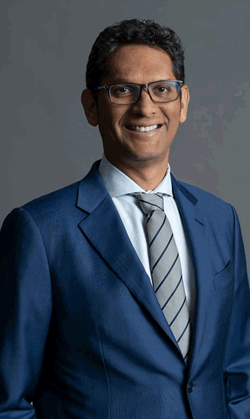CCUS has emerged as a key technology in the push for net zero, but costs need to fall sharply to make it viable at scale, while more needs to be done to convince the public of its credibility. Carbon Economist spoke with Gavin Rennick, president of SLB’s New Energy business, at the Gastech conference in Singapore about these challenges and the ways to address them.
Deployment of CCUS globally is accelerating, but what does it really take to advance a project to FID?
Rennick: It is about the right partners, technology and delivery capabilities that enable the lifecycle economics, from when you start and conceive the project, to the point of FID, and then execute post-FID construction and operations. The reality is that this takes time.
There are supportive policies in some places, but some are not yet actionable at the moment. Government departments and administrations need to be able to actually deploy policies that enable projects to go through feasibility and permitting efficiently, then move forward.
The other part is inflation. Some of these projects started at a point in time when all of the costs associated with construction were at least 10% less than what they are today. So, by pure definition of inflation, costs are at least 10% higher.
You solve this by scaling up and delivering bigger, better, more efficient, derisked projects. We have 45 million tons per year of CO₂ right now being injected around the world in total. And there is one project that we are involved with in the Middle East which, when all its phases are completed, will have a potential capacity of around 50mt by itself. We do need to scale both the size and the number of projects that enter construction.
And then you have got to bring the costs down as well.
Carbon capture represents the largest cost in the CCUS value chain. Reducing carbon capture cost materially improves the economics of a project. This means that the capital and operating expenditures associated to carbon capture have to come down, via smaller size equipment designs, lower energy requirements, lower grade alloys, etc.
And then you modularise your system design to reduce your engineering costs and you do a number of other things to make it more cost-effective. And all of a sudden you get something that works economically for a customer. We are working closely on some projects with [industrial gases company] Linde, particularly around natural gas. We are seeing some success in those spaces already thanks to improved economics.
Tell us more about SLB’s capture technology and its role in reducing costs.
Rennick: We need to dramatically lower the cost of capture. And that is not about one technology, that is about specific technologies targeting specific use cases based on their size and based on the type of effluent stream they are treating.
We have been public about two things that we are working on now. One is a sorbent-based technology where we acquired exclusive rights to further develop and deploy from a research company in the US, and the other one is a non-aqueous solvent-based technology—so one is chemical, and one is physical.
Both of them have specific use cases and significant benefits in those use cases.
Both of them have the potential to drop the cost of capture by anywhere between 30% and 50%.
If you look at some of the active carbon capture projects in the world on a power generation station, you can consume 20–30% of the power actually running the capture unit. So, 30% parasitic load makes it difficult to stand up some of these projects. You cut that down by a half or less and, all of a sudden, the economics work in your favour. Things like [US tax credit] 45Q that make a project become more viable if your capital cost and your energy cost is lower.
There are two key cost drivers with carbon capture: the capital cost of the equipment and plant fabrication, and the energy cost and operations.
All of our technology work—from pure research into completely new stuff through to what we have announced and are building into products—is focused on lowering the cost of capture in specific applications, often collaborating with end users.
Turning to the storage side of the business, what are the key challenges?
Rennick: Below the ground, there is a social responsibility problem. If you look at the places that are challenging to get permits for, it is really about education and it is about technology to give people comfort that, when we inject CO₂ and sequester it, it goes in the way we intended it to, it stays there in the way we intend it, and that we can do it for a long enough time.
We obviously have a significant portfolio of subsurface technologies, whether that is in reservoir simulation, geochemistry, formation evaluation, or measurement, monitoring and verification. Can you accurately measure what is going in the ground and can you validate that it is staying there? We have been doing that for CCUS for decades.
First, we need to make sure that these feasibility studies for carbon storage are done in a consistent science-based, pragmatic and independent approach. Today, we advise CO2 storage project developers, land owners, emitters, and governments when it comes to providing insights associated to the safe and economic storage of carbon dioxide. We use all technical, and non-technical available data to screen and rank possible storage sites, based on risk-weighted criteria, and leveraging proprietary tools and surface to subsurface workflows. Our reservoir models are supported by AI and cloud computing, enhancing processing capabilities, and accelerating scenario simulations.
The other challenge becomes to take all of that and translate it out of engineer language into something the public and the politicians can look at. And doing it in a systematic and traceable way, can give them confidence that this is a real viable material decarbonisation option. We believe there is no viable path to net zero without gigatons [of CCUS capacity].
Do you think more needs to be done to convince the public that CCUS is a credible and realistic part of the net-zero solution, especially from the fossil fuel side?
Rennick: I absolutely do. And I think we need to be way more open and active in communicating externally to the public.
Using a close analogy, we currently deploy an interesting innovative technology for using geoenergy for cooling and heating of buildings. In the system installation, as part of the solution, there is a big TV screen, which has a display that is showing in real time the amount of energy coming into the building, what is going into the ground, what is being consumed, and how much is being saved, and emissions as well.
We should be able to have exactly the same thing sitting at the front of a CO₂ injection plant so when the public drive past we can say this is how many tonnes of CO₂ we are actually safely storing here.
And when we are comfortable doing that, which you can be if you have the technology that is measuring it, the act of being that open is going to instil more public confidence. But we have not done that yet, and it needs to happen in the next few years.









Comments